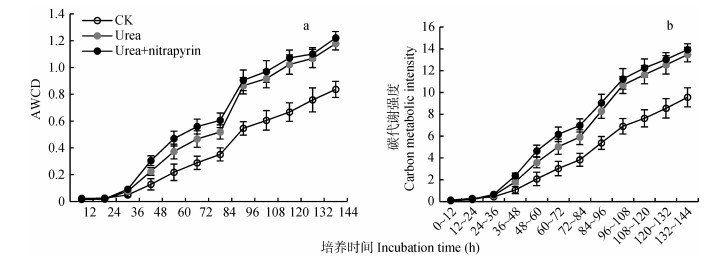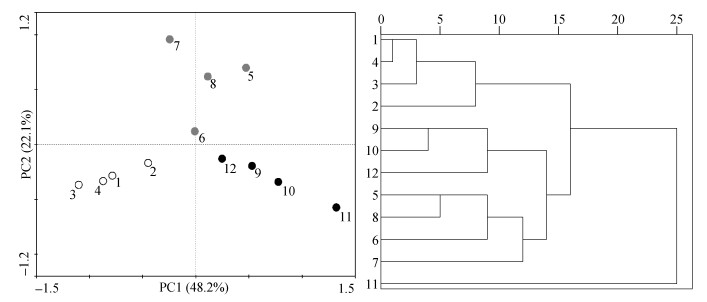Effect of nitrapyrin on functional diversity of soil microbial community in drip-fertigated cotton field
-
摘要: 已知硝化抑制剂氯甲基吡啶能有效抑制土壤硝化,减少氮的淋洗和硝化-反硝化损失,促进作物对氮素的吸收,但是其对干旱区滴灌条件下土壤微生物群落功能多样性的影响尚不明确。本试验研究了尿素添加氯甲基吡啶(Nitrapyrin)分次随水滴施对干旱区滴灌棉田土壤微生物碳代谢和群落功能多样性的影响。试验采用随机区组设计,设置不施氮肥[CK,0 kg(N)·hm-2]、单施尿素[Urea,225 kg(N)·hm-2]和尿素添加氯甲基吡啶[Urea+nitrapyrin,225 kg(N)·hm-2+2.25 kg(nitrapyrin)·hm-2] 3个处理,重复4次,采用Biolog-ECO法进行土壤微生物碳代谢和功能多样性研究。结果表明:与不施氮肥(CK)相比,施用尿素和尿素添加氯甲基吡啶均能显著提高土壤微生物对31种碳源的代谢能力(AWCD)和代谢强度(S)(P < 0.05),增加土壤微生物多样性和丰富度(Shannon指数、Simpson指数、McIntosh指数和Richness指数)以及对各类碳源的利用能力。尿素添加氯甲基吡啶随水滴施后,土壤微生物AWCD值、碳代谢强度、Shannon指数、Simpson指数、McIntosh指数以及Richness指数均大于单施尿素处理,且较单施尿素处理分别提高13.83%、9.33%、1.29%、1.34%、11.26%、11.79%(P > 0.05),均匀度指数则低于单施尿素处理(P > 0.05)。PCA和聚类分析结果表明,施用尿素和尿素添加氯甲基吡啶对土壤微生物群落功能多样性均产生了显著影响,但尿素添加氯甲基吡啶与单施尿素处理差异不显著;氯甲基吡啶的添加提高了土壤微生物对聚合物、酚酸、羧酸、氨基酸以及胺类的利用,降低了对碳水化合物的利用(P > 0.05)。上述研究结果得出,在干旱区滴灌棉田,尿素添加氯甲基吡啶分次随水滴施可调控土壤的微生态环境,在一定程度上提高土壤微生物的代谢能力,增加微生物群落功能多样性,缓解因长期施用无机氮肥导致的土壤微生物活性的降低。Abstract: As one of the nitrification inhibitors (NIs), nitrapyrin (2-chloro-6-(trichloromethyl)-pyridine) exhibits some effective influences on controlling nitrification, reducing nitrogen leaching and nitrification-denitrification losses, increasing crop nitrogen uptake.However, information is still scant regarding the effect of nitrapyrin on the functional diversity of soil microbial community under drip irrigation condition in arid area.In view of this, a field trial (of randomized block design) was conducted to evaluate the impact of repeated supply of nitrapyrin with urea via fertigation on the functional diversity of soil microbial community in a drip-fertigated cotton field.Three treatments were established:CK[0 kg (N)·hm-2], Urea[225 kg (N)·hm-2]and Urea+nitrapyrin[225 kg (N)·hm-2+2.25 kg (nitrapyrin)·hm-2], each treatment was replicated three times.Biolog-ECO technology was used to explore carbon metabolism and community functional diversity of soil microbial.The results showed that the application of urea and urea plus nitrapyrin significantly increased metabolic capacity of 31 carbon sources (AWCD) and intensity of carbon metabolism (S) of soil microbial community compared with CK (P < 0.05), it also increased the diversity and richness of soil microbial community[Shannon index (H'), Simpson index (D), McIntosh index (U) and Richness index (R)]and improved the utilization of six types of carbon sources used by soil microbial community to some extent.Urea+nitrapyrin treatment increased AWCD, S, H', D, U and R of soil microbial community respectively by 13.83%, 9.33%, 1.29%, 1.34%, 11.26% and 11.79%(P > 0.05), it decreased Pielou evenness index (J)(P > 0.05) compared with Urea treatment.Principal component analysis and cluster analysis indicated that the application of urea and urea plus nitrapyrin significantly influenced the functional diversity of soil microbial community.However, there was no significant difference between Urea and Urea+nitrapyrin treatments.Furthermore, the addition of nitrapyrin increased the utilization of polymers, phenolic acids, carboxylic acids, amino acids and amines by soil microbial community, but decreased the utilization of carbohydrates compare with Urea treatment (P > 0.05).The results demonstrated that the repeated supply of nitrapyrin with urea via fertigation regulated soil micro-ecological environment, increased soil microbial metabolism and functional diversity of community.It inhibited the reduction of soil microbial activity due to long-term application of inorganic nitrogen fertilizers in drip-fertigated cotton fields in arid areas.
-
Keywords:
- Nitrapyrin /
- Soil microbial /
- Carbon metabolism /
- Community functional diversity /
- Drip-fertigation /
- Cotton field
-
图 1 施用尿素和尿素添加氯甲基吡啶后土壤微生物AWCD值(a)和碳代谢强度(b)变化
CK:不施肥对照; Urea:尿素; Urea+nitrapyrin:尿素添加氯甲基吡啶。
Figure 1. Changes of AWCD (a) and carbon metabolic intensity (b) under incubation condition after application of urea and urea plus nitrapyrin
CK: no fertilization; Urea: urea application; Urea+nitrapyrin: urea plus nitrapyrin application.
图 2 施用尿素和尿素添加氯甲基吡啶后土壤微生物对不同类型碳源利用能力的变化
CK:不施肥对照; Urea:尿素; Urea+nitrapyrin:尿素添加氯甲基吡啶。同一碳源中不同字母表示差异显著(P < 0.05)。
Figure 2. Change of utilization of different carbon source of soil microbial after application of urea and urea plus nitrapyrin
CK: no fertilization; Urea: urea application; Urea+nitrapyrin: urea plus nitrapyrin application. Different letters in the same carbon source mean significantly different (P < 0.05).
图 3 施用尿素和尿素添加氯甲基吡啶后土壤微生物群落主成分分析(a)和聚类分析(b)
1、2、3、4为不施肥对照的4个重复, 5、6、7、8为尿素处理的4个重复, 9、10、11、12为尿素添加氯甲基吡啶处理的4个重复。
Figure 3. Principal components analysis (a) and cluster analysis (b) of soil microbial communities after application of urea and urea plus nitrapyrin
1, 2, 3 and 4 are four replicates of CK; 5, 6, 7 and 8 are four replicates of urea application treatment; 9, 10, 11 and 12 are four replicated of urea plus nitrapyrin application treatment.
表 1 施用尿素和尿素添加氯甲基吡啶后土壤微生物多样性指数、丰富度指数以及均匀度指数
Table 1 Diversity index, richness index and evenness index of soil microbial communities after application of urea and urea plus nitrapyrin (means±SD, n=3)
处理
Treatment香农指数
Shannon-wiener index (H′)辛普森指数
Simpson index (D)McIntosh指数
McIntosh index (U)丰富度指数
Richness index (R)均匀度指数
Pielou evenness index (J)CK 2.78±0.16a 0.92±0.03a 2.42±0.28b 17±1.73a 1.04±0.07a Urea 2.91±0.05a 0.92±0.02a 3.91±0.26a 18±2.31a 1.02±0.04a Urea+nitrapyrin 2.94±0.12a 0.94±0.01a 4.35±0.23a 20±2.22a 0.99±0.01a 同列中不同字母表示差异显著(P < 0.05)。CK:不施肥对照; Urea:尿素; Urea+nitrapyrin:尿素添加氯甲基吡啶。Different letters in the same column mean significantly different (P < 0.05). CK: no fertilization; Urea: urea application; Urea+nitrapyrin: urea plus nitrapyrin application. -
[1] Giller K E, Beare M H, Lavelle P, et al. Agricultural intensi-fication, soil biodiversity and agroecosystem function[J]. Applied Soil Ecology, 1997, 6(1):3-16 doi: 10.1016/S0929-1393(96)00149-7
[2] Micks P, Aber J D, Boone R D, et al. Short-term soil respira-tion and nitrogen immobilization response to nitrogen appli-cations in control and nitrogen-enriched temperate forests[J]. Forest Ecology and Management, 2004, 196(1):57-70 doi: 10.1016/j.foreco.2004.03.012
[3] Lovell R D, Jarvis S C, Bardgett R D. Soil microbial biomass and activity in long-term grassland:Effects of management changes[J]. Soil Biology and Biochemistry, 1995, 27(7):969-975 doi: 10.1016/0038-0717(94)00241-R
[4] Amberger A. Research on dicyandiamide as a nitrification inhibitor and future outlook[J]. Communications in Soil Science and Plant Analysis, 1989, 20(19/20):1933-1955 doi: 10.1080/00103628909368195
[5] Zerulla W, Barth T, Dressel J, et al. 3, 4-Dimethylpyrazole phosphate(DMPP)-A new nitrification inhibitor for agri-culture and horticulture[J]. Biology and Fertility of Soils, 2001, 34(2):79-84 doi: 10.1007/s003740100380
[6] Macadam X M B, Prado A D, Merino P, et al. Dicyandiamide and 3, 4-dimethylpyrazole phosphate decrease N2O emissions from grassland but dicyandiamide produces deleterious effects in clover[J]. Journal of Plant Physiology, 2003, 160(12):1517-1523 doi: 10.1078/0176-1617-01006
[7] 刘涛, 梁永超, 褚贵新, 等.三种硝化抑制剂在石灰性土壤中的应用效果比较[J].土壤, 2011, 43(5):758-762 http://www.cnki.com.cn/Article/CJFDTOTAL-TURA201105013.htm Liu T, Liang Y C, Chu G X, et al. Effect comparison of three different types of nitrification inhibitors (DCD, DMPP and Nitrapyrin) in calcareous soils[J]. Soils, 2011, 43(5):758-762 http://www.cnki.com.cn/Article/CJFDTOTAL-TURA201105013.htm
[8] 李兆君, 宋阿琳, 范分良, 等.几种吡啶类化合物对土壤硝化的抑制作用比较[J].中国生态农业学报, 2012, 20(5):561-565 http://www.ecoagri.ac.cn/zgstny/ch/reader/view_abstract.aspx?file_no=2012508&flag=1 Li Z J, Song A L, Fan F L, et al. Comparative studies on soil nitrification inhibition by pyridine compounds[J]. Chinese Journal of Eco-Agriculture, 2012, 20(5):561-565 http://www.ecoagri.ac.cn/zgstny/ch/reader/view_abstract.aspx?file_no=2012508&flag=1
[9] 刘涛, 陶瑞, 李君, 等.氯甲基吡啶对滴灌棉花生物量、氮素吸收及氮肥利用率的影响[J].棉花学报, 2015, 27(5):463-468 doi: 10.11963/issn.1002-7807.201505010 Liu T, Tao R, Li J, et al. Effect of nitrapyrin on biomass, ni-trogen uptake and nitrogen use efficiency in drip-irrigated cotton plants[J]. Cotton Science, 2015, 27(5):463-468 doi: 10.11963/issn.1002-7807.201505010
[10] Harch B D, Correll R L, Meech W, et al. Using the Gini coef-ficient with BIOLOG substrate utilization data to provide an alternative quantitative measure for comparing bacterial soil communities[J]. Journal of Microbiological Methods, 1997, 30(1):91-101 doi: 10.1016/S0167-7012(97)00048-1
[11] Garland J L, Mills A L. Classification and characterization of heterotrophic microbial communities on the basis of pat-terns of community-level sole-carbon-source utilization[J]. Applied and Environmental Microbiology, 1991, 57(8):2351-2359 https://www.researchgate.net/publication/38060479_Community-Level_Physiological_Profiling
[12] Guckert J B, Carr G J, Johnson T D, et al. Community analy-sis by Biolog:Curve integration for statistical analysis of ac-tivated sludge microbial habitats[J]. Journal of Microbiologi-cal Methods, 1996, 27(2/3):183-197
[13] Shannon C E. A mathematical theory of communication[J]. ACM SIGMOBILE Mobile Computing and Communications Review, 2001, 5(1):3-55 doi: 10.1145/584091
[14] Simpson E H. Measurement of diversity[J]. Nature, 1949, 163(4148):688 doi: 10.1038/163688a0
[15] 李志斐, 王广军, 谢骏, 等.草鱼养殖池塘生物膜固着微生物群落碳代谢Biolog分析[J].水产学报, 2014, 38(12):1985-1995 http://www.cnki.com.cn/Article/CJFDTOTAL-SCKX201412006.htm Li Z F, Wang G J, Xie J, et al. Microbial carbon metabolic characteristics of biofilm communities in the grass carp cul-ture pond based on Biolog-ECO plates[J]. Journal of Fisheries of China, 2014, 38(12):1985-1995 http://www.cnki.com.cn/Article/CJFDTOTAL-SCKX201412006.htm
[16] Rogers B F, Lii R L T. Temporal analysis of the soil microbial community along a toposequence in Pineland soils[J]. Soil Biology and Biochemistry, 2001, 33(10):1389-1401 doi: 10.1016/S0038-0717(01)00044-X
[17] Pielou E C. Mathematical Ecology[M]. New York:John Wiley & Sons Inc, 1975
[18] 郑丽萍, 龙涛, 林玉锁, 等. Biolog-ECO解析有机氯农药污染场地土壤微生物群落功能多样性特征[J].应用与环境生物学报, 2013, 19(5):759-765 http://www.cnki.com.cn/Article/CJFDTOTAL-YYHS201305005.htm Zheng L P, Long T, Lin Y S, et al. Biolog-ECO analysis of microbial community functional diversity in organochlorine contaminated soil[J]. Chinese Journal of Applied and Envi-ronmental Biology, 2013, 19(5):759-765 http://www.cnki.com.cn/Article/CJFDTOTAL-YYHS201305005.htm
[19] 高晓奇, 肖能文, 叶瑶, 等.基于Biolog-ECO分析长庆油田土壤微生物群落功能多样性特征[J].应用与环境生物学报, 2014, 20(5):913-918 http://www.cnki.com.cn/Article/CJFDTOTAL-YYHS201405025.htm Gao X Q, Xiao N W, Ye Y, et al. Analysis of microbial community functional diversity in the Changqing oilfield based on Biology-ECO method[J]. Chinese Journal of Ap-plied and Environmental Biology, 2014, 20(5):913-918 http://www.cnki.com.cn/Article/CJFDTOTAL-YYHS201405025.htm
[20] Karolien D, Dries R, Mihiricwmanimel W, et al. Microbial community composition and rhizodeposit-carbon assimilation in differently managed temperate grassland soils[J]. Soil Biology and Biochemistry, 2009, 41(1):144-153 doi: 10.1016/j.soilbio.2008.10.008
[21] 罗明, 文启凯, 陈全家, 等.不同用量的氮磷化肥对棉田土壤微生物区系及活性的影响[J].土壤通报, 2000, 31(2):66-69 http://www.cnki.com.cn/Article/CJFDTOTAL-TRTB200002005.htm Luo M, Wen Q K, Chen Q J, et al. Influences of different ni-trogen and phosphorus fertilizers on soil microflora and mi-crobial activities in cottoned soil[J]. Chinese Journal of Soil Science, 2000, 31(2):66-69 http://www.cnki.com.cn/Article/CJFDTOTAL-TRTB200002005.htm
[22] 夏雪, 谷洁, 车升国, 等.施氮水平对塿土微生物群落和酶活性的影响[J].中国农业科学, 2011, 44(8):1618-1627 doi: 10.3864/j.issn.0578-1752.2011.08.010 Xia X, Gu J, Che S G, et al. Effects of nitrogen application rates on microbial community and enzyme activities in Lou soil[J]. Scientia Agricultura Sinica, 2011, 44(8):1618-1627 doi: 10.3864/j.issn.0578-1752.2011.08.010
[23] 侯晓杰, 汪景宽, 李世朋.不同施肥处理与地膜覆盖对土壤微生物群落功能多样性的影响[J].生态学报, 2007, 27(2):655-661 http://www.cnki.com.cn/Article/CJFDTOTAL-STXB200702028.htm Hou X J, Wang J K, Li S P. Effects of different fertilization and plastic-mulching on functional diversity of soil microbial community[J]. Acta Ecologica Sinica, 2007, 27(2):655-661 http://www.cnki.com.cn/Article/CJFDTOTAL-STXB200702028.htm
[24] Fauci M F, Dick R P. Soil microbial dynamics:Short-and long-term effects of inorganic and organic nitrogen[J]. Soil Science Society of America Journal, 1994, 58(3):801-806 doi: 10.2136/sssaj1994.03615995005800030023x
[25] Sarathchandra S U, Ghani A, Yeates G W, et al. Effect of ni-trogen and phosphate fertilisers on microbial and nematode diversity in pasture soils[J]. Soil Biology and Biochemistry, 2001, 33(7/8):953-964
[26] Bending G D, Lincoln S D. Inhibition of soil nitrifying bacteria communities and their activities by glucosinolate hydrolysis products[J]. Soil Biology and Biochemistry, 2000, 32(8/9):1261-1269 http://www.sciencedirect.com/science/article/pii/S0038071700000432
[27] 孙志梅, 武志杰, 陈利军, 等.土壤硝化作用的抑制剂调控及其机理[J].应用生态学报, 2008, 19(6):1389-1395 http://www.cnki.com.cn/Article/CJFDTOTAL-YYSB200806034.htm Sun Z M, Wu Z J, Chen L J, et al. Regulation of soil nitrifi-cation with nitrification inhibitors and related mechanisms[J]. Chinese Journal of Applied Ecology, 2008, 19(6):1389-1395 http://www.cnki.com.cn/Article/CJFDTOTAL-YYSB200806034.htm
[28] 刘生辉, 吴萌, 胡锋, 等.添加硝化抑制剂DMPP对红壤水稻土硝化作用及微生物群落功能多样性的影响[J].土壤, 2015, 47(2):349-355 http://www.cnki.com.cn/Article/CJFDTOTAL-TURA201502024.htm Liu S H, Wu M, Hu F, et al. Effect of DMPP on nitrification and functional diversity of microbial community in red paddy soil[J]. Soils, 2015, 47(2):349-35 http://www.cnki.com.cn/Article/CJFDTOTAL-TURA201502024.htm




 下载:
下载:


